It's no exaggeration that fungi are the glue that holds all of life on Earth together. Estimated to number upwards of 5 million species, their stunning level of diversity offers a lot of jobs to do, from decomposing dead organic matter to symbiotic or even parasitic relationships with other organisms. Without these lifeforms, most plants could not absorb nutrients in the soil and the carbon cycle in forests would be all but impossible.
Yet, many people are really only familiar with one type of fungi: the kind that produce mushrooms, which are a type of growth we can think of like a fruit, though fungi are very different from plants. The majority of the mushroom fungus is actually underground, forming a dense web of stringy connective tissue called mycelium. When the mycelium wants to reproduce, it sprouts mushrooms, which are typically in the form of stalks with spore-dribbling gills beneath domed caps.
Sure, that may seem obvious: everyone knows what a mushroom is. Even if many folks only know a handful of species at the grocery store or the iconic red and white Amanita muscaria, for good reason, mushrooms are really popular right now, and not just the psychedelic kind that are driving a paradigm shift in how we treat mental health.
"I think the central thing driving the burgeoning fascination with fungi is that they really are super cool!" Roo Vandegrift, a mycologist at the University of Oregon's Institute of Ecology and Evolution, told Salon in an email. He said the lessons from fungi can challenge the dominant narrative that we must compete to survive, something people desperately need right now as the relentless maw of capitalism squeezes the life from this planet.
"I think there has been a cultural need for symbols of connection, for means of connection, and mycology has become a way to meet that need," Vandegrift said. "The ecology of symbiosis, so inextricable from the study of fungi, gives a view of the world that includes cooperation and collaboration as fundamental aspects of reality, part of the bedrock from which our world is built."
One of the best ways to indulge such an attitude is to go mushroom hunting. Vandegrift recommends joining a local mycology club to go on hikes and poke around for, as mycologist David Arora put it, "All That the Rain Promises and More..."
"You can participate in group activities, have ready access to expert identifiers, learn good spots and techniques and make friends!" Vandegrift said. "The North American Mycological Association has affiliated clubs all over the country. There's probably one near you."
Vandegrift was one of many contributors to "National Audubon Society Mushrooms of North America," a new 720-page, full-color guidebook showcasing hundreds of magnificent fungal fruits that make this continent special. We picked out some of the most absolutely bonkers-looking mushrooms — the kind that make you go, "Wait, that's a mushroom?" — that graced the book's pages for your viewing pleasure.
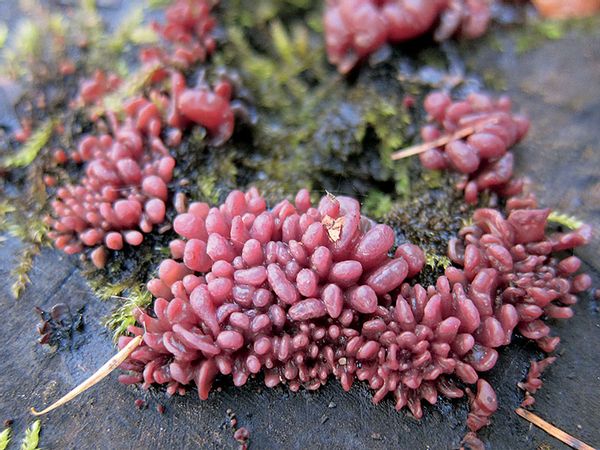 Purple Jellydisc (Henk Monster)Image_placeholder
Purple Jellydisc (Henk Monster)Image_placeholderLike some kind of strange blob from outer space, purple jellydisc, also known as jelly drops, are made up of tightly squished growths in the shape of a chewed up gumball or a tiny brain. Its distinctive rosey amethyst color is thanks to a chemical the fungus produces called ascocorynin, which has weak antibiotic activity. It is found throughout North America, aside from Gulf Coast states.
"We've actually collected this species from Ecuador, as well as some other species in the genus, including at least one that's likely new to science. We're still working on it, so stay tuned!" Vandegrift said, noting that it can reproduce one of two ways: using spores and sometimes asexually.
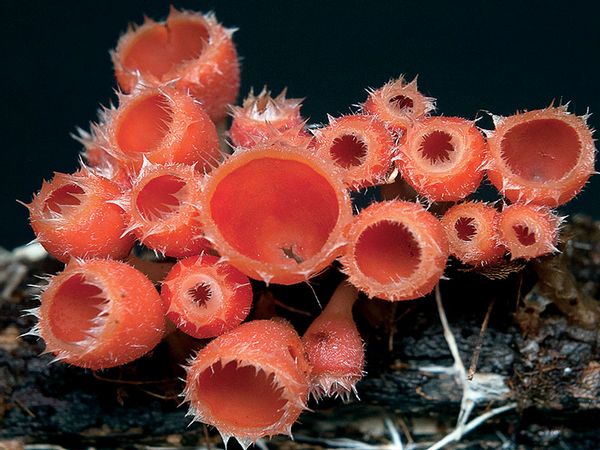 Shaggy Rose Goblet (AJ (j7u))placeholder
Shaggy Rose Goblet (AJ (j7u))placeholder Camarops petersii (Dog's Nose) (Katja Schulz)e_placeholder
Camarops petersii (Dog's Nose) (Katja Schulz)e_placeholderTrue to its name, this shiny, black, speckled mushroom looks exactly like the snoot on a dog. It's even somewhat square-like in some instances. But don't actually boop it — it can stain your fingers a slimy black when touched. Found throughout the east, it "erupts" from a light brown sheath that sometimes sticks around or disintegrates.
"The texture of the fruiting bodies is unlike any other fungus I've ever encountered," Vandegrift said. "Like the Ascocoryne [purple jellydisc], I've collected a related species in Ecuador. It actually confused me for a long time. I specialize in Xylariaceae, the family of the Candlesnuff Fungus, Xylaria hypoxylon, and these at first really look like they should be in that family, but they're not."
This level of confusion isn't uncommon in mycology. Many, many fungi look alike and sometimes the only way to tell species apart is by running genetic tests. When Camarops petersii was given the DNA treatment, it "allowed for a deeper understanding of the relationships between groups," Vandegrift explained. "In 2001, based on DNA evidence, Camarops (and a few closely-related fungi) were given their own order level classification, the Boliniales, reflecting how unique they really are."
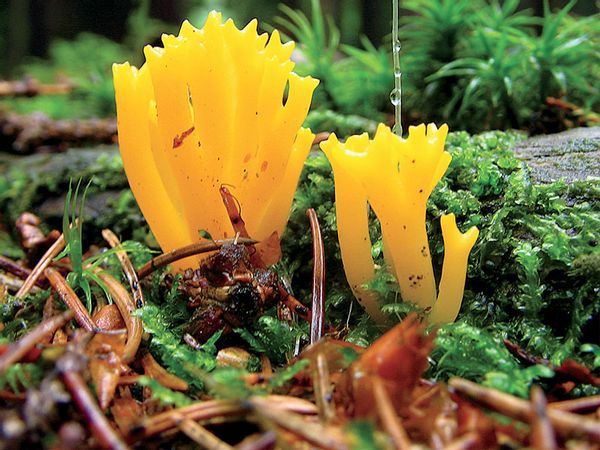 Staghorn Jelly (Taka)e_placeholder
Staghorn Jelly (Taka)e_placeholderThis shocking coral fungi can resemble licking tongues of flame, ranging from lemon yellow to a burnt orange. Those weird "tuning fork" structures (technically called basidia) don't just look cool, they help it shoot out microscopic spores to reproduce. The fungus is riddled with carotenoids, the pigmented chemicals in many plants and animals that produce vivid yellows, oranges and reds, notably in pumpkins, carrots, lobster, flamingos and shrimp.
It's not poisonous, but you probably don't want to eat it anyway. It has a pretty gross taste and a gelatinous, rubbery texture, though some creative chefs have used it to garnish dishes. It is commonly found throughout the whole country.
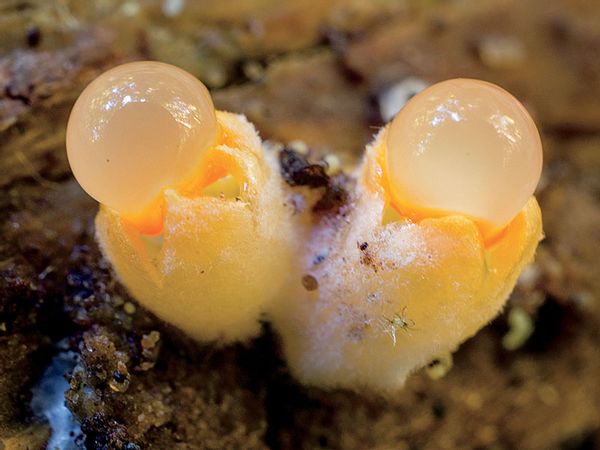 Shooting Star (Sava Krstic (sava))placeholder
Shooting Star (Sava Krstic (sava))placeholderEventually, this pearly globe will be jettisoned up to six meters (!) away from the mushroom, generating 1/10,000th of a horsepower, leaving behind a liquidy pool of milky white or pinkish tissue. All of this is possible thanks to a specialized membrane that flips inside out, almost exactly like those elastic jumping popper toys.
Even more intriguing, this species is phototropic, meaning it can sense light, giving it the ability to aim its sticky packages at whatever's brightest, which it tends to prefer. Unfortunately, this is often highly reflective surfaces such as light-colored walls or glass. Which brings us to the next point…
As cool as all this sounds, the poor shooting star mushroom is considered a pest by many. It leaves unsightly black spots everywhere it lands, whether that's a parked car, someone's window or the side of their home. They are the bane of homeowners and insurance companies, who are not amused by the tiny destructive power of these mini howitzers.
Want more health and science stories in your inbox? Subscribe to Salon's weekly newsletter The Vulgar Scientist.
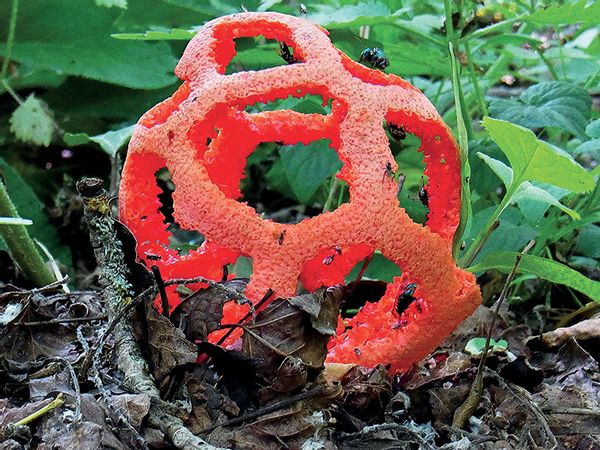 Red Basket Stinkhorn (Siga)placeholder
Red Basket Stinkhorn (Siga)placeholderThis horror show resembles something you might see in a David Cronenberg film, or perhaps a geodesic dome one would spot at Burning Man. It emerges first as a whitish egg, but soon, like a chest-bursting alien, it rips through and expands its spongy, blood-orange lattices that can feature between seven to twenty windows. It starts to spread a jelly-like slime called a gleba, which is a nauseating greenish-black color that contains its spores.
It smells hellish too, like rotting meat on a sweltering day, which magnetizes tons of insects that scatter its spores. In North America, it is found strictly in California, particularly in the San Francisco Bay area and Santa Barbara, but it is spreading and may have been introduced to Europe or vice versa. If you can get past the terrible stench, yes, you can eat it. Some folks even pickle it while it's still in its egg stage, which is considered a delicacy in some parts of Europe and Asia.
 Hydnellum peckii (Bleeding Tooth) (Alan Rockefeller)e_placeholder
Hydnellum peckii (Bleeding Tooth) (Alan Rockefeller)e_placeholderTruly a mushroom that is not for the faint of heart, or especially anyone afraid of the dentist. Also called Devil's tooth, Hydnellum peckii starts out as a blobby, funnel-shaped mushroom with pinkish white caps that weep a red, blood-colored fluid. This strange sweat, technically known as guttation, is similar to sap in plants.
The shroom has fine, fuzzy hairs that feel like velvet and even has teeth-like structures of its own, also known as hymenium, which are spore-bearing surfaces of a mushroom, typically gills. Its range stretches from the Gulf Coast through the Appalachians and into the northeast Great Lakes region. Despite its gruesome appearance, this mushroom is beneficial for the coniferous trees it colonizes. The plants give the fungi carbon dioxide while the mushroom breaks down minerals into the soil for the tree to absorb better.
If you're brave enough to eat it, it has a strong bitter or peppery hot flavor. Some people also call this mushroom Strawberries and Cream, so clearly not everyone thinks this thing is super gross. And its more outrageous stage is short-lived. After a while, the mushroom fades into a boring brown color.
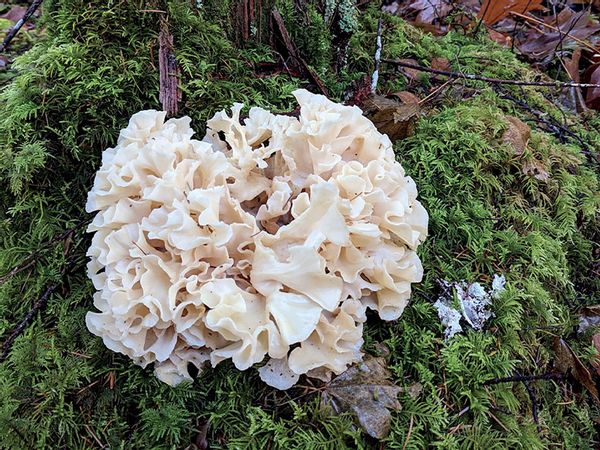 Western Cauliflower Mushroom (nonototo)
Western Cauliflower Mushroom (nonototo)This wavy mushroom more closely resembles the frilly white shirt from an episode of "Seinfeld" or a bowl of pale egg noodles than cauliflower. A single fruiting body can get quite heavy and feature hundreds of distinct, smooth lobes that are free of pores or wrinkles. Found throughout the Pacific Northwest and Northern California, Sparassis radicata is actually a weak parasite that feeds on conifers, but isn't very deadly.
"This is one of my favorite mushrooms to eat!" Vandegrift said. "A lot of guides to cooking wild mushrooms recommend making soup out of it, but I've never quite understood that. The best part of this mushroom is the delightful texture! I chop it fine and sauté it with cumin and coriander to make taco filling, and it's exquisite. And then, use the firm, compact interior like soup bones to make hearty mushroom stock: I dry them in slabs and just add one to the pot whenever I make a soup. Same goes for the firm interior parts of Chicken of the Woods — just because it's too tough to eat doesn't mean it's not still delicious for making broths!"
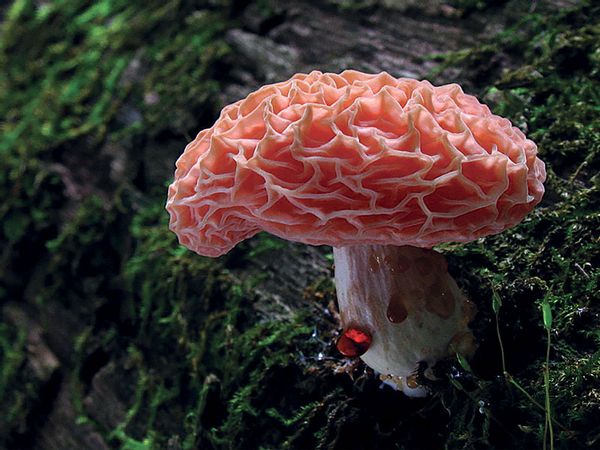 Wrinkled Peach (Dan Molter (shroomydan))
Wrinkled Peach (Dan Molter (shroomydan))Nothing else really looks like this puckered up, ballet slipper-colored weirdo, but unfortunately, it is rarely seen to begin with. Rhodotus palmatus is both veiny and gelatinous and like Bleeding Tooth, it excretes a golden, sometimes ruby goo. It is found in the East from Kansas to Virginia and further north, but also many other places across the globe, where it loves to feed on rotting elm wood.
In the middle of the 20th Century, three species of another fungi under the genus Ophiostoma swept through North America and Europe, sickening trees with what's known as Dutch elm disease. Spread by bark beetles, this destructive parasite causes trees (but especially elms) to wither and die, starkly transforming forests with its massive death toll.
At first this gave R. palmatus plenty of food to eat, causing its population to jump, but later, it dropped precipitously. It is now considered near threatened and many mushroom enthusiasts eagerly seek it out, knowing its rarity.
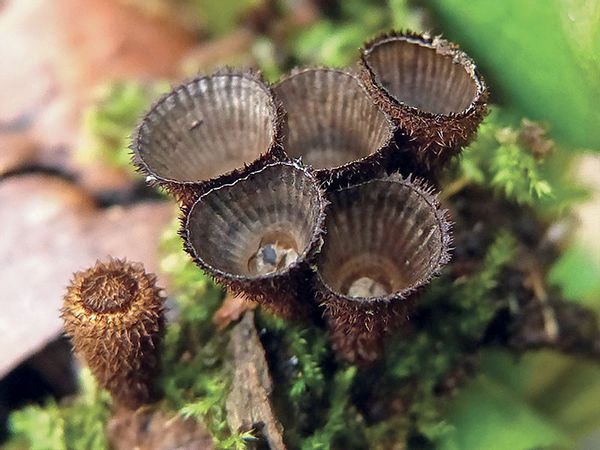 Fluted Bird's Nest (Christian Grenier)_placeholder
Fluted Bird's Nest (Christian Grenier)_placeholderThere are quite a few mushrooms that have evolved a very unique way of dispersing their spores: by shaping themselves to look exactly like a bird's nest full of eggs. Most fungi in this family have shallow bowls, but the Fluted Bird's Nest is more funnel-shaped, with its ribbed tube faceted by spiky, wooly tufts. It is found almost everywhere in North America, sometimes in hundreds of swarms squished together.
"The 'eggs' in the bottom of the nest are really peridioles, which are sort of like eggs, in that they are the first step to making the next generation of this fungus, but they're very different in other ways," Vandegrift explained. Each peridilole is a mass of thousands of spores, some of which have long sticky cords attached, . "And that's where the magic of the bird's nest fungus comes in: they don't stay stuck at the bottom. The nest itself is a specially constructed structure to help get the peridioles out. The shape and size of the cup is calibrated by the fungus to be just perfect for splashing."
Raindrops that splash into these cups, especially on the rim, launch the peridioles out and into the air. If the raindrop hits hard enough, its cord then acts like a snapping rubber band, which gives it the ability to wrap around plants, helping disperse even more spores.
The world of fungi, especially in fiction like "The Last of Us," is often depicted as disgusting and deadly. That's great for entertainment, but it's only slightly a reflection of the real-world threats fungi pose to humans. For the most part, they are harmless to us and just cool to look at.
Certainly, fungi have seemingly endless different forms they can take, especially when it comes to their weird fruit. Mushrooms are just one of many ways these fascinating organisms have used evolution to create truly mind-blowing works of art.



Shares